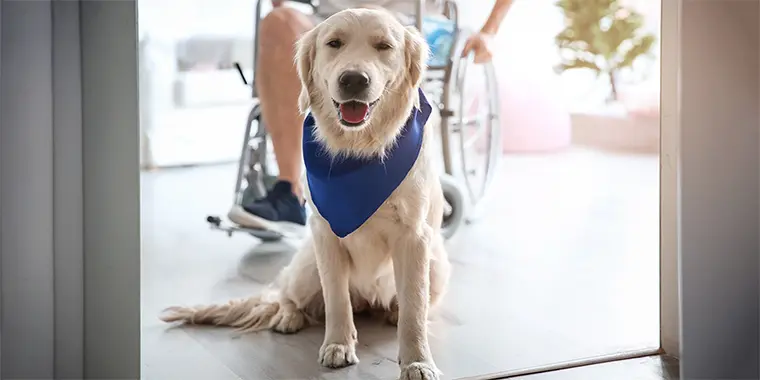
A cardiac service dog supports people with heart conditions impacting their life. Cardiac service dogs can help people with a wide range of cardiac conditions. Some common conditions include:
The Most Common Cardiac Disability We Train
- Postural Orthostatic Tachycardia Syndrome (POTS): POTS is a condition that causes a number of symptoms when you transition from lying down to standing up, such as a fast heart rate, dizziness and fatigue.
While there’s no cure, several treatments and lifestyle changes can help manage the symptoms of POTS. The causes of POTS vary from person to person. Researchers don’t entirely understand the origins of this disorder. The classification of POTS is the subject of discussion, but most authorities recognize different characteristics in POTS, which occur in some patients more than others. Importantly, these characteristics are not mutually exclusive; person with POTS may experience more than of these at the same time. We regularly train cardiac service dogs for POTS. Sarah has POTS and her dog Storm is a cardiac service dog. We understand this condition very well.- Neuropathic POTS is a term used to describe POTS associated with damage to the small fiber nerves (small-fiber neuropathy). These nerves regulate the constriction of the blood vessels in the limbs and abdomen.
- Hyperadrenergic POTS is a term used to describe POTS associated with elevated levels of the stress hormone norepinephrine.
- Hypovolemic POTS is a term used to describe POTS associated with abnormally low levels of blood (hypovolemia).
- Secondary POTS means that POTS is associated with another condition known to potentially cause autonomic neuropathy, such as diabetes, Lyme disease, or autoimmune disorders such as lupus or Sjögren’s syndrome.
Other Common Cardiac Disabilities
- Cardiomyopathy: Cardiomyopathy (kahr-dee-o-my-OP-uh-thee) is a disease of the heart muscle that makes it harder for the heart to pump blood to the rest of the body. Cardiomyopathy can lead to heart failure.
- Ventricular Tachycardia: Ventricular tachycardia (VT) is a fast, abnormal heart rhythm (arrhythmia). It starts in your heart’s lower chambers, called the ventricles. VT is defined as three or more heartbeats in a row at a rate of more than 100 beats a minute. If VT lasts for more than a few seconds at a time, it can become life-threatening.
- Orthostatic Hypotension: Orthostatic hypotension manifests as abnormal blood pressure regulation due to various conditions. It is not a specific disorder. However, orthostatic hypotension increases the risk of cardiovascular disease and mortality.
- Inappropriate Sinus Tachycardia: Sinus tachycardia is a regular cardiac rhythm in which the heart beats faster than normal. While it is common to have tachycardia as a physiological response to exercise or stress, it causes concern when it occurs at rest.
- Wolff-Parkinson-White Syndrome: In Wolff-Parkinson-White (WPW) syndrome, an extra signaling pathway between the heart’s upper and lower chambers causes a fast heartbeat (tachycardia). WPW syndrome is a heart condition present at birth (congenital heart defect). It is fairly rare.
How Cardiac Service Dogs Help
Cardiac service dogs can provide many benefits to people with heart conditions. The essential benefit of any service dog is increased independence. This is something abled-bodies people never have to think about. But a service dog is a game changer once one’s independence is impacted. Our service dogs are all custom-trained for each client, so tasks vary widely, even with something as specific as a cardiac service dog. However, common service tasks clients request for their cardiac service dogs include:
Common Cardiac Service Dog Tasks
- Heart Rate Alert/Response: A cardiac service dog can alert you when your heart rate changes outside your normal range (custom to you). A dog could also bring medication, get help, dial 911 on a dog phone, and many other things.
- Blood Pressure Alert/Response: A cardiac service dog can alert you when your blood pressure changes outside your normal range (custom to you). A dog could also bring medication, get help, dial 911 on a dog phone, and many other things.
- Deep Pressure Therapy (DPT): Many cardiac clients benefit from deep pressure therapy (i.e., laying on legs) when they are sitting or lying down.
- Medication Reminder/Retrieval: When your phone reminds you to take your medication, you can swipe the alarm away. Many people want their cardiac service dog to help them remember. This is usually done by the dog responding to the phone alert and not stopping until you do what you’re supposed to.
- Item Pickup/Retrieval: For people with POTS or other cardiac conditions bending down to pick something up can lead to passing out. A cardiac service dog can help with that.
- Other Tasks: There are many more tasks a cardiac service dog can perform. If a dog can do it, we can train it.
These are just some examples of how a cardiac service dog can help. Please also check our Giant List of Service Dog Tasks for more suggestions and examples.
